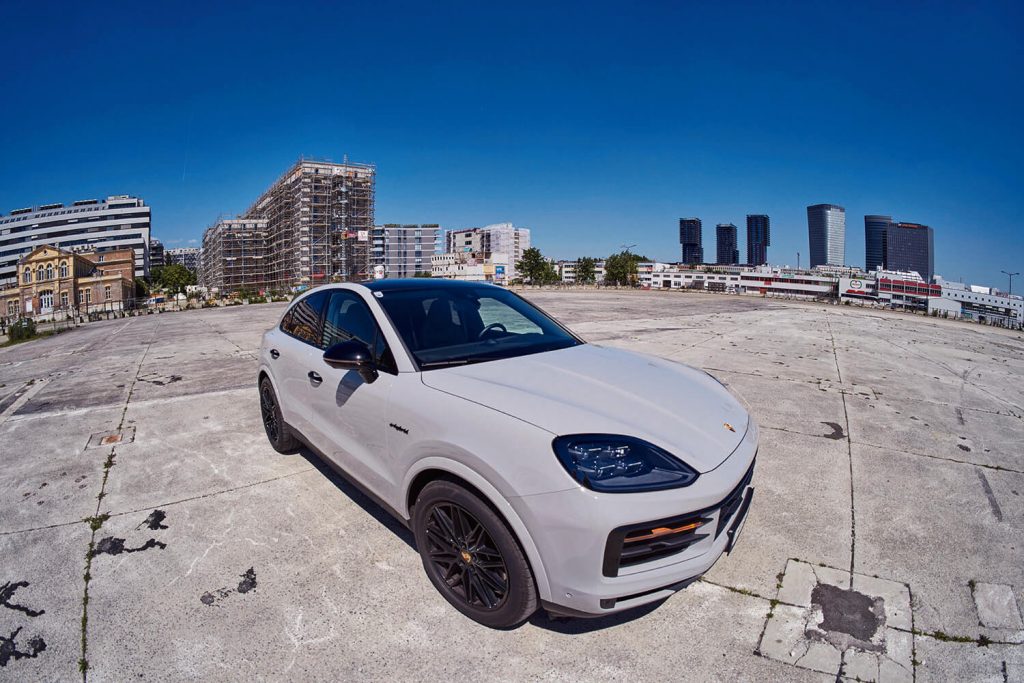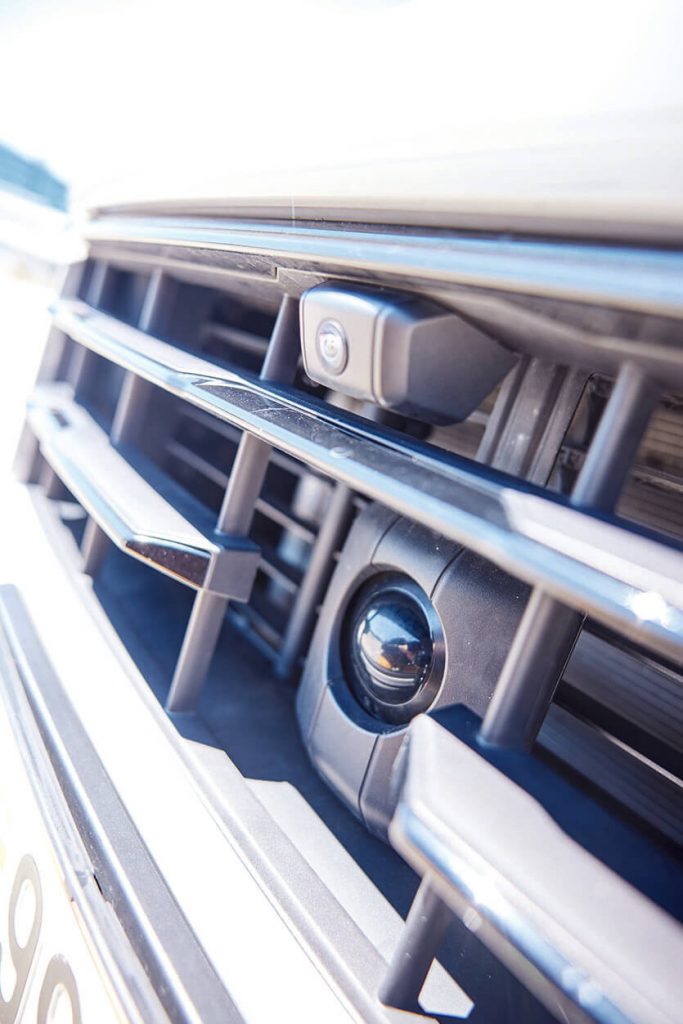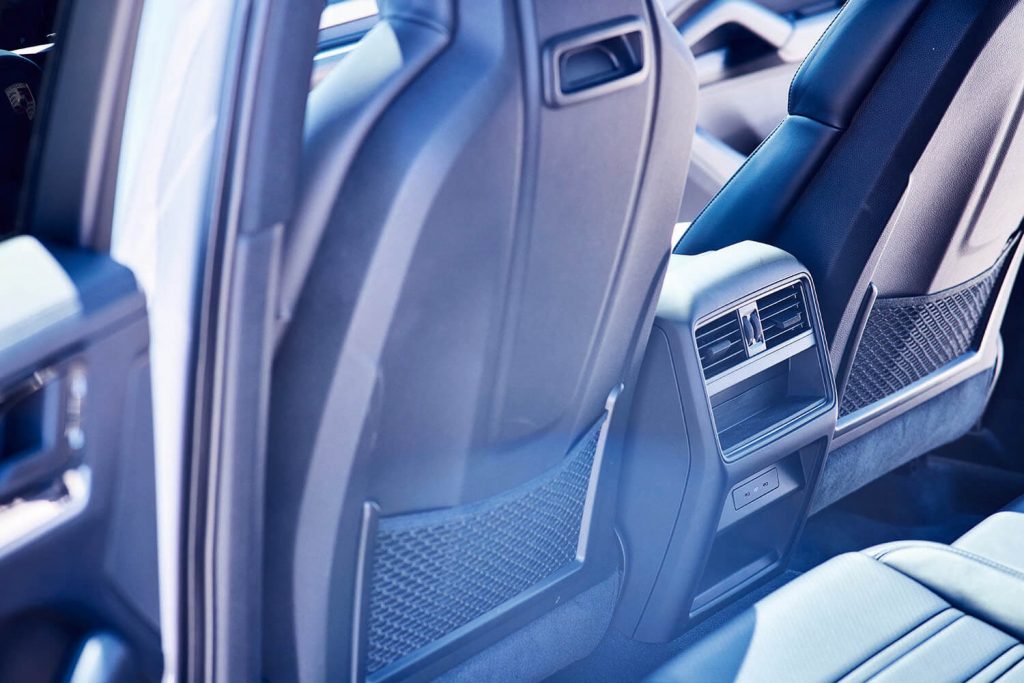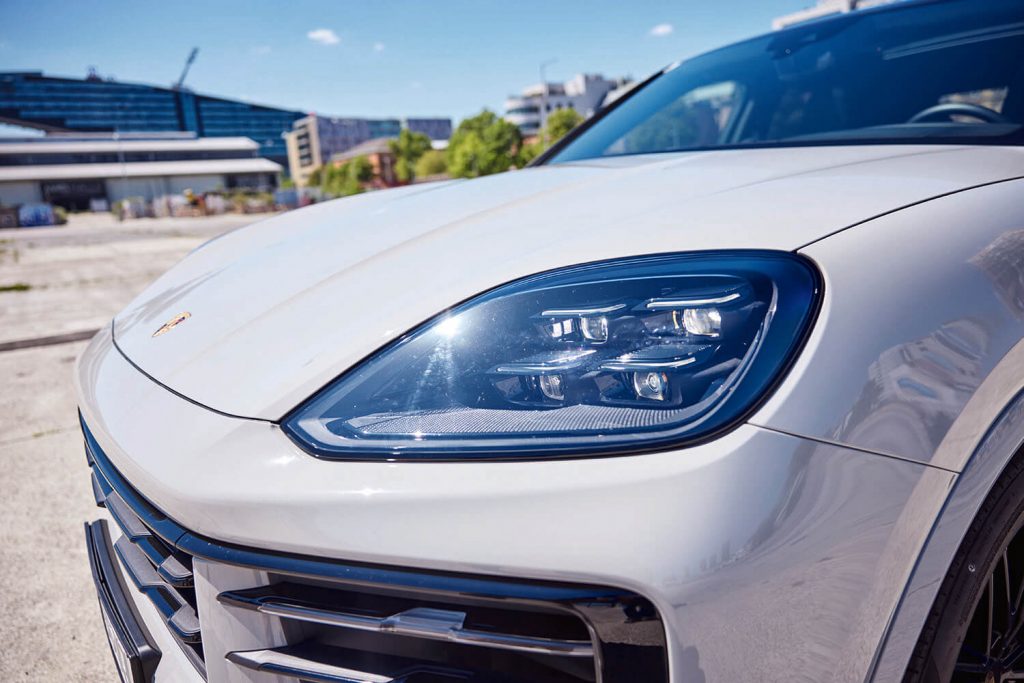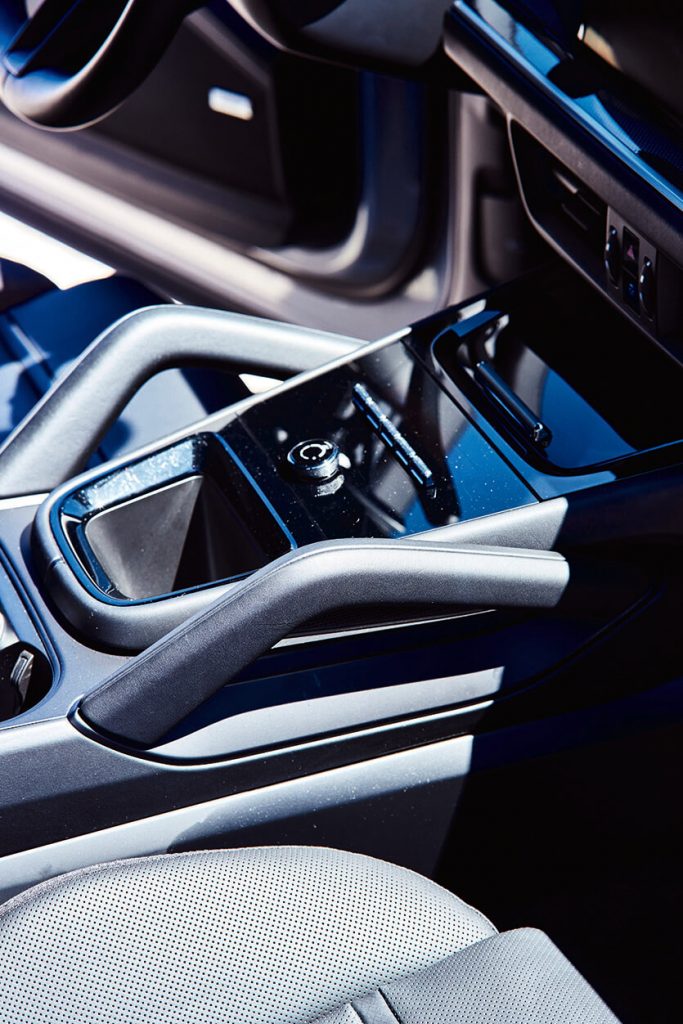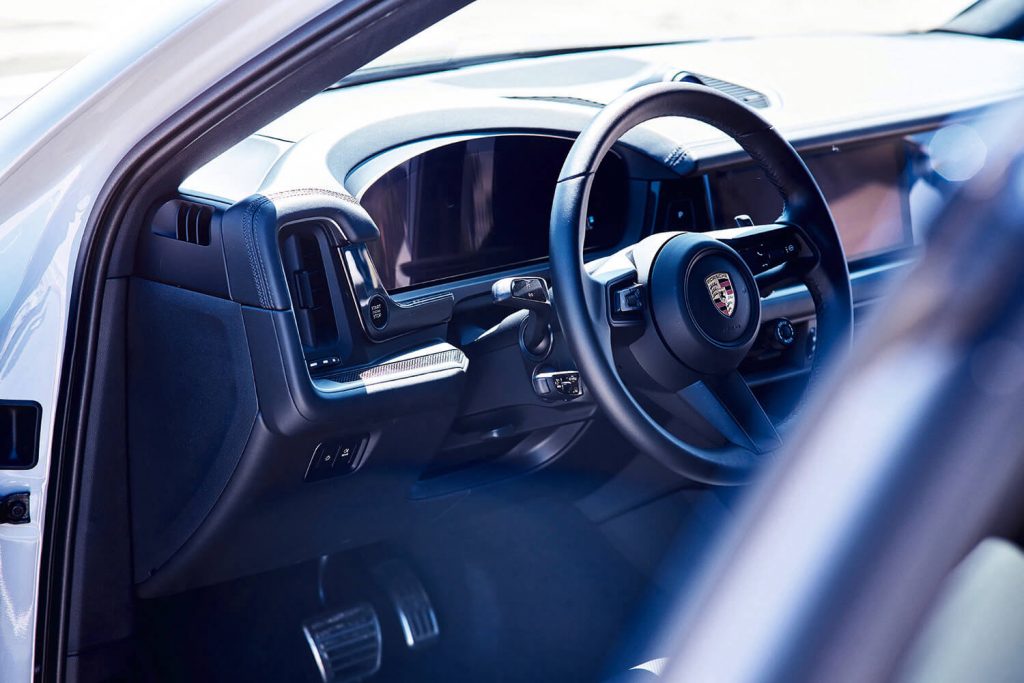
Fully digital instruments with a dedicated display for the front passenger.
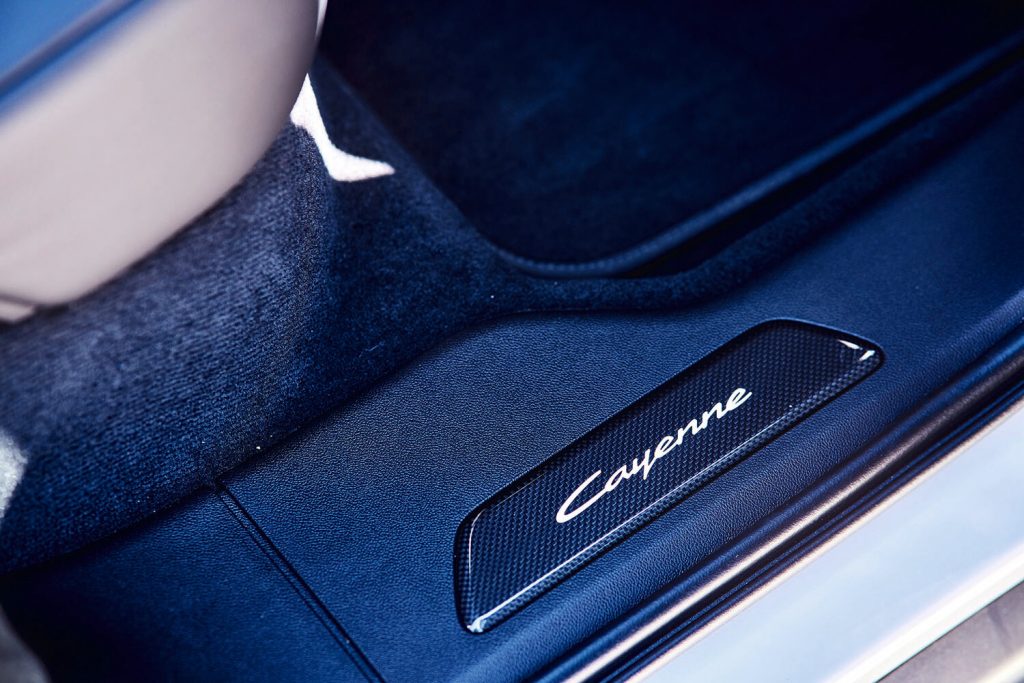
This could also say “Welcome.” Illuminated.
The outcry was tremendous. It echoed 22 years ago when Porsche launched the first Cayenne. There was misunderstanding, ridicule, and anger everywhere: The mighty “Sport Utility Vehicle” was considered a sacrilege to the heritage of the storied sports car brand in 2002. However, this sentiment was primarily shared by those who either drove a Porsche 911 or fervently wished for one. They judged harshly, claiming that the new model – four- door, high-riding, station wagon-like, and heavy – could not be a “real Porsche.” Others simply bought it, making the Cayenne the best-selling model of the Zuffenhausen manufacturer
in no time. The critics had to begrudgingly acknowledge that even a diesel engine in the Porsche Cayenne did not deter buyers but rather attracted even more.
Note: SUVs are not called SUVs by accident and do not harm the success of a noble sports car brand – quite the contrary. In China, the Porsche brand has long
been regarded as an SUV manufacturer that also produces sports cars on the side. We are now on the third generation of the Cayenne, or more accurately, the
three-and-a-halfth, if there is such a thing. Last year, the Cayenne was thoroughly revamped, with Porsche describing it as one of the most comprehensive
product upgrades in the brand’s history, across all model ranges. The cockpit saw extensive digitization, even placing a generously sized infotainment display on the passenger side. This allows for the enjoyment of streamed videos to shorten boring drives, although it’s unclear which drives in this car could be boring enough to warrant such a desire. Externally, the matrix LED main headlights stand out; in the test car shown, they are even HD matrix LED headlights – a seemingly perplexing term that simply means many small, bright LED light sources illuminate the road at night together. Each headlight contains 32,000 pixels. These can be individually turned on and off and dimmed in over a thousand levels; oncoming vehicles are “spared” from the light beam, ensuring their drivers are not dazzled even with high beams on.
What fascinates about the Porsche Cayenne is primarily the ease and precision with which this massive vehicle can be driven – less pronounced in city traffic, of course, than on country roads. The hybrid drive of our sporty SUV, weighing in at two and a half tons, contributes significantly to this. It comprises a three-liter V6 engine delivering 304 PS and an electric motor producing 176 PS. Since these two power units do not reach their respective maximum outputs simultaneously, the total system output is not the sum of 480 PS but 10 PS less. This shortfall is easily forgiven as the power and torque are more than sufficient to accelerate the Cayenne from 0 to 100 km/h in less than five seconds and reach a top speed of 254 km/h, not permitted on public roads here. Oh, wait: You can drive this fast on the Red Bull Ring, where the Cayenne feels right at home on the racetrack. Dynamic driving – not an easy task for vehicle developers when it comes to heavy cars with a high center of gravity due to a voluminous body. An SUV is not a flat sports car whose ride comfort must be somewhat subordinated to optimizing dynamic driving behavior.
For this reason, there are hardly any SUVs on the Austrian market that can
match the Cayenne in this regard. The recipe of Porsche’s engineers combines a robust steel chassis with the proven, electronically controlled PASM. This acronym stands for “Porsche Active Suspension Management,” an active damping system with an extremely short reaction time. In milliseconds, the shock absorbers stiffen during quick evasive maneuvers, ensuring secure wheel contact with the road. During high-speed straight-line driving, the PASM smooths out road imperfections much better than conventional suspension systems. Additionally, the driving mode can be selected between Normal, Sport, and the even stiffer Sport Plus, according to preference. An adaptive air suspension further enhancescomfort on request.
Porsche drivers usually know what they are doing, yet the Cayenne boasts
numerous electronic assistance systems that support both novice and seasoned drivers. Some are legally mandated, while others are quite exclusive – for instance, a system that ensures speed limits are not overlooked if desired, and the evasive assistant can be useful in sudden emergency situations.
In other plug-in hybrid vehicles that are not Porsches, the question of the distance achievable on electric power alone often takes precedence over driving performance. But even here, the Cayenne E-Hybrid does not disappoint: With a range of 73 kilometers, the commute from the suburbs, where lawyers, architects, or chief physicians like to reside, to the office, studio, or clinic can be easily handled electrically all week long, as can the return trip late at night. The Porsche is likely to be plugged into the wall box overnight in the garage, which, thanks to the increased battery capacity of 25.9 kilowatt-hours, may not even be necessary every evening. Only on weekends, when, for example, relaxation at Lake Neusiedl or Lake Attersee is sought, does the internal combustion engine come into play for long-distance travel. This exact application aligns with the intentions of the plug-in hybrid drive’s inventors.
The Porsche Cayenne is available in two different body variants; we drove the
coupe, which differs from the otherwise station wagon-like contour of the conventional Cayenne by its sloping rear silhouette. The choice is primarily a matter of taste, as the SUV coupe also offers ample space for five passengers, and the restriction in the luggage compartment due to the slightly lower-set tailgate is negligible. The coupe, however, offers an irreplaceable “aha” moment: standing to the right (or left) behind the car and looking along its flank towards the front, you can unmistakably see echoes of Porsche’s legendary classic – the 911 – in the rear fender area and the rounding of the small third side window.

